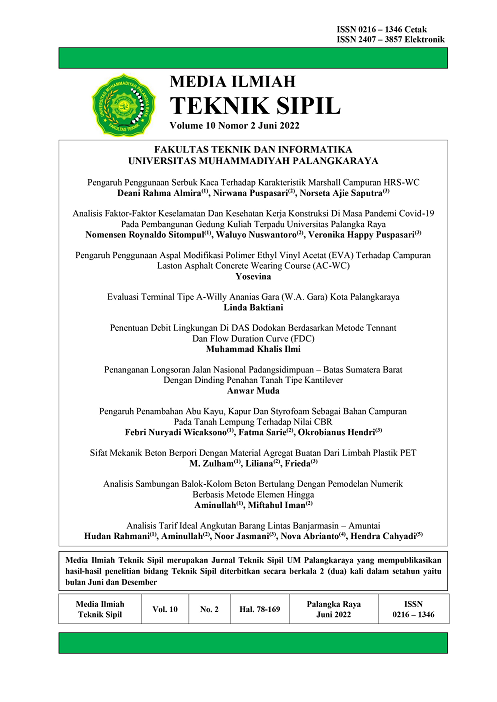Sifat Mekanik Beton Berpori Dengan Material Agregat Buatan Dari Limbah Plastik PET Mechanical Properties Of Porous Concrete With Artificial Aggregate Material From PET Plastic Waste
Main Article Content
Abstract
The use of plastic without any recycling action from human hands will result in the accumulation of plastic waste that damages the environment. Making plastic waste as an artificial aggregate is one way to overcome it. This research was conducted using an experimental method, namely by substituting natural aggregate with artificial aggregate of 58% in porous concrete. Aggregate:cement ratio used is 6:1 and 7:1 with variations of FAS used are 0.25 and 0.30. The tests carried out are compressive tests, tensile tests, and porosity tests. From the results of the compressive strength test, the maximum compressive strength was 6.700 kg/cm2 in the mixture used, namely 58% artificial aggregate: 42% natural aggregate, 6:1 aggregate:cement ratio, and 0.30 FAS. In the tensile strength test, the largest tensile strength was 0.802 kg/cm2 in the mixture used, namely 58% artificial aggregate: 42% natural aggregate, 6:1 aggregate:cement ratio, and 0.30 FAS. While the porosity test obtained the largest porosity of 5.04 in the mixture used, namely 58% artificial aggregate: 42% natural aggregate, 7:1 aggregate:cement ratio, and 0.25 FAS. The porous concrete in this study did not meet the specifications for the road body because it had a small compressive strength and a small tensile strength
Downloads
Article Details
All rights reserved. This publication may be reproduced, stored in a retrieval system, or transmitted in any form or by any means, electronic, mechanical, photocopying, recording.
References
Murdock, L.J. dan Brook, K.M., 1991, Bahan dan Praktek Beton, Edisi Keempat, Terjemahan oleh Stephanus Hindarko, Jakarta : Erlangga.
Arnoldus,F.F. 2012. Studi Analisa Pengaruh Dimensi Agregat Terhadap Nilai Kuat Tekan Dan Tingkat Porositas Air Untuk Beton Berpori Dengan Bahan Tambahan Fly Ash Pada Aplikasi Sidewalk. Jakarta : Binus University.
Rosie, Arizki Intan Sari., E. Wallah, Steenie., S. Windahm Reky. 2015. Pengearuh Jumlah Semen dan FAS Terhadap Kuat Tekan Beton dengan Agregat yang Berasal dari Sungai. Jurnal Sipil Statik. 03(01). hal 68 – 76.
Ari Prabowo, Daryanto., Setyawan, Ary., dan Adi Sambowo, Kusno. 2013. Desain Beton Berpori Untuk Perkerasan Jalan yang Ramah Lingkungan. e-Jurnal Matriks Teknik Sipil. 06(01), hal 96 – 102.
Widiyatmoko, H., Purwaningrum, Pramiati., dan Putri Arum P, Febrina. 2016. Analisis Karakter Sampah Plastik di Permukiman Kecamatan Tebet dan Alternatif Pengolahannya. Jurnal Teknik Lingkungan FALT Universitas Trisakti. 07(01), hal 24 – 33.
Widhiarto, H., dan Sujatmiko, B. 2012. Analisis Campuran Beton Berpori dengan Agregat Bergradasi Terpisah Ditinjau Terhadap Mutu dan Biaya. Jurnal Teknik Sipil Untag Surabaya. 05(02), hal 24 – 30.
